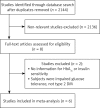Effects of continuous positive airway pressure treatment on glycaemic control and insulin sensitivity in patients with obstructive sleep apnoea and type 2 diabetes: a meta-analysis
- PMID: 25276145
- PMCID: PMC4175764
- DOI: 10.5114/aoms.2014.44854
Effects of continuous positive airway pressure treatment on glycaemic control and insulin sensitivity in patients with obstructive sleep apnoea and type 2 diabetes: a meta-analysis
Abstract
Introduction: Obstructive sleep apnoea (OSA) is a prevalent disorder characterised by repetitive upper-airway obstruction during sleep, and it is associated with type 2 diabetes. Continuous positive airway pressure (CPAP) is the primary treatment for OSA. Prior studies investigating whether CPAP can improve insulin resistance or glucose control in OSA patients have resulted in conflicting findings. This meta-analysis investigated whether CPAP treatment could improve glucose metabolism and insulin resistance in patients with OSA and type 2 diabetes.
Material and methods: We performed a systematic literature search using Medline, Cochrane, EMBASE, and Google Scholar databases for randomised controlled prospective studies that investigated the effect of CPAP on glycaemic control or insulin sensitivity in subjects with type 2 diabetes.
Results: The combined standard (STD) paired difference in mean change in the levels of glycated haemoglobin (HbA1c) was -0.073% (standard error (SE): 0.126), indicating that CPAP treatment did not alter HbA1c levels. The combined STD paired difference in mean change of insulin sensitivity was observed as 0.552 µmol/kg • min (SE = 0.196) and indicated insulin sensitivity significantly increased with CPAP treatment (p = 0.005).
Conclusions: We found that the CPAP treatment did not alter HbA1c levels but did significantly improve insulin resistance, indicating treating OSA can positively impact the symptoms of type 2 diabetes.
Keywords: glycaemic control; insulin resistance; obstructive airway apnoea; positive airway pressure.
Figures




Similar articles
-
Benefits of continuous positive airway pressure on glycaemic control and insulin resistance in patients with type 2 diabetes and obstructive sleep apnoea: A meta-analysis.Diabetes Obes Metab. 2021 Feb;23(2):540-548. doi: 10.1111/dom.14247. Epub 2020 Dec 2. Diabetes Obes Metab. 2021. PMID: 33146450
-
Effect of Continuous Positive Airway Pressure on Glucose and Lipid Profiles in Patients With Obstructive Sleep Apnoea: A Systematic Review and Meta-Analysis of Randomized Controlled Trials.Arch Bronconeumol. 2023 Jun;59(6):370-376. doi: 10.1016/j.arbres.2023.03.012. Epub 2023 Mar 21. Arch Bronconeumol. 2023. PMID: 37024342 English, Spanish.
-
Randomised, cOntrolled Multicentre trial of 26 weeks subcutaneous liraglutide (a glucagon-like peptide-1 receptor Agonist), with or without contiNuous positive airway pressure (CPAP), in patients with type 2 diabetes mellitus (T2DM) and obstructive sleep apnoEa (OSA) (ROMANCE): study protocol assessing the effects of weight loss on the apnea-hypnoea index (AHI).BMJ Open. 2020 Jul 22;10(7):e038856. doi: 10.1136/bmjopen-2020-038856. BMJ Open. 2020. PMID: 32699168 Free PMC article.
-
Effect of CPAP on insulin resistance and HbA1c in men with obstructive sleep apnoea and type 2 diabetes.Thorax. 2007 Nov;62(11):969-74. doi: 10.1136/thx.2006.074351. Epub 2007 Jun 8. Thorax. 2007. PMID: 17557769 Free PMC article. Clinical Trial.
-
Efficacy of continuous positive airway pressure (CPAP) preventing type 2 diabetes mellitus in patients with obstructive sleep apnea hypopnea syndrome (OSAHS) and insulin resistance: a systematic review and meta-analysis.Sleep Med. 2019 Oct;62:14-21. doi: 10.1016/j.sleep.2018.12.017. Epub 2019 Jan 7. Sleep Med. 2019. PMID: 31518943
Cited by
-
Effect of continuous positive airway pressure on glucose metabolism in adults with type 2 diabetes: a systematic review and meta-analysis of randomized controlled trials.Sleep Breath. 2018 May;22(2):287-295. doi: 10.1007/s11325-017-1554-x. Epub 2017 Aug 15. Sleep Breath. 2018. PMID: 28812180
-
Obesity, obstructive sleep apnea and type 2 diabetes mellitus: Epidemiology and pathophysiologic insights.Sleep Med Disord. 2018;2(3):52-58. Epub 2018 Jun 21. Sleep Med Disord. 2018. PMID: 30167574 Free PMC article.
-
Sleep Disorders and Cardio-Renal Disease: Implications for Minority Populations.Epidemiology (Sunnyvale). 2016;6(3):e120. doi: 10.4172/2161-1165.1000e120. Epub 2016 Jun 14. Epidemiology (Sunnyvale). 2016. PMID: 27478683 Free PMC article.
-
MicroRNA-21 regulates the viability and apoptosis of diffuse large B-cell lymphoma cells by upregulating B cell lymphoma-2.Exp Ther Med. 2017 Nov;14(5):4489-4496. doi: 10.3892/etm.2017.5021. Epub 2017 Aug 24. Exp Ther Med. 2017. PMID: 29067124 Free PMC article.
-
DNA Methylation Profiling of Blood Monocytes in Patients With Obesity Hypoventilation Syndrome: Effect of Positive Airway Pressure Treatment.Chest. 2016 Jul;150(1):91-101. doi: 10.1016/j.chest.2016.02.648. Epub 2016 Feb 26. Chest. 2016. PMID: 26923628 Free PMC article.
References
-
- Ip MS, Lam B, Ng MM, Lam WK, Tsang KW, Lam KS. Obstructive sleep apnea is independently associated with insulin resistance. Am J Respir Crit Care Med. 2002;165:670–6. - PubMed
-
- Punjabi NM, Shahar E, Redline S, et al. Sleep-disordered breathing, glucose intolerance, and insulin resistance: the Sleep Heart Health Study. Am J Epidemiol. 2004;160:521–30. - PubMed
-
- Punjabi NM, Sorkin JD, Katzel LI, Goldberg AP, Schwartz AR, Smith PL. Sleep-disordered breathing and insulin resistance in middle-aged and overweight men. Am J Respir Crit Care Med. 2002;165:677–82. - PubMed
-
- Levy P, Bonsignore MR, Eckel J. Sleep, sleep-disordered breathing and metabolic consequences. Eur Respir J. 2009;34:243–60. - PubMed
Publication types
LinkOut - more resources
Full Text Sources
Other Literature Sources
Research Materials
